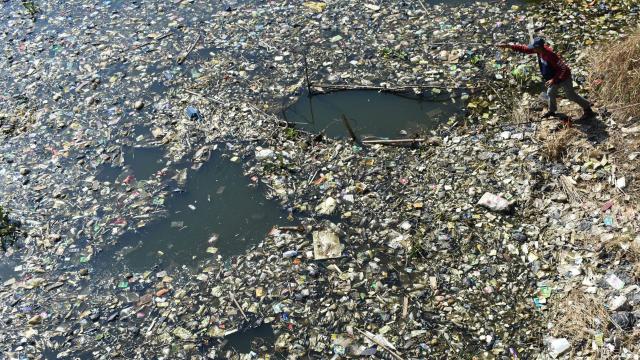Humans have produced an estimated 10 billion metric tons of plastic since the industrial era, most which has ended up as permanent waste in the environment that will define Homo sapiens’ legacy in the fossil record.
While the risen in recent years. Where the rest of the pervasive materials are settling and in what quantity is unknown—a plastic budgeting discrepancy of a magnitude that researchers are only just beginning to understand.
A new study presented at the American Geophysical Union (AGU) fall meeting in San Francisco last week has uncovered one of the final resting places of plastic that far exceeds total calculated global surface ocean plastic: the world’s rivers.
Researchers have viewed rivers as highways for plastic to enter the sea and not as significant places where plastic accumulates. But the preliminary results of a global effort to establish a baseline for plastic contamination indicates rivers are a massively underrepresented hotspot of plastic pollutants.
[referenced url=” thumb=” title=” excerpt=”]
“We show in this study that the accumulation of plastic in river corridors is several orders of magnitude greater than the amount of plastics found in the world’s oceans,” reads the stunning abstract of the report, which is currently under peer review for publication in Nature Geoscience. “Our model-based quantification reveals that rivers do not solely function as pure conduits for plastics travelling to the oceans, but also represent long-term sinks, with in particular microplastics being buried in streambeds and floodplain sediments.”
The research is part of the 100 Plastic Rivers Project, which crowdsources river sampling from a global network of volunteers following a standardised collection procedure. The project, led by University of Birmingham researcher Stefan Krause, mails kits with detailed instructions for collecting sediment samples from specific rivers near streamflow gauges. Once they’re sent back to the lab, Krause’s team analyses primary microplastics, such as microbeads used in cosmetics and microfibers from clothing as well as secondary microplastics, which are fragments of larger plastic items that have broken down over time. These tiny pieces of plastic measure less than five millimetres in size, and many are invisible to the naked eye. Microplastics and their smaller brethren known as nanoplastics make up the family of plastic pollutants finding permanent residence in the environment.
Krause has been surprised by how many people have participated in the project. But more shocking still are the results showing the variety and concentration of microplastics far from human sources. The results show that plastic is in the waterways and also getting trapped in streambeds and floodplain sediment, leaving a legacy of plastic all around the world.
“You get a feeling with the analysis we are doing now what the global spread is,” Krause told Earther. “You get a feeling of how much the problem really penetrates the whole of the environment and not just the oceans or the coast or the rivers. It’s everywhere.”
Jenni Brandon, a senior scientist at consulting firm Applied Ocean Sciences whose research has looked at the abundance and distribution of microplastics and wasn’t involved in the study, told Earther the initial findings surprised her as well.
“A lot of people really think about it the opposite way––they think about rivers having a lot of the bigger plastic before the plastic has broken down,” she said. “You’re closer to the consumers where the plastic is directly being polluted and it hasn’t had time to break down. By the time it gets to the middle of the ocean it has had years—maybe decades—of sitting in the sunlight and breaking down.”
While the new study sheds light on river plastic pollution, Brandon also pointed out there are other parts of Earth where plastic could be accumulating that remain poorly studied—including undersampled parts of the ocean. The deep sea in particular could be throwing off plastic budget calculations. Forty per cent of all plastic produced is made to be more dense than water so it sinks quickly, she said. Other floating ocean plastic could become coated in organic gunk and eventually sink to the deep sea as well.
“And then the thing we are just starting to tap into is the animal transport of how much plastic is just floating through the food chain as reservoirs of plastic right now,” Brandon said.
How the industrial chemicals are being ingested and what their effect is on organisms is central to understanding the danger of microplastic to human health. In August, the World Health Organisation called for an increase in research on microplastic and the exposure risk to humans. The call comes at a time when stashes of microplastic are showing up basically everywhere.
Plastic particles have been found in the air, snow, the Arctic, drinking water, and even beer. Recent estimates indicate that Americans eat and inhale more than 70,000 microplastic particles each year—or about a credit card’s weight in plastic per week. And that may be conservative estimate because some pieces of microplastic are so small, they are undetectable.
Current estimates suggest eight million metric tons of plastic enter the oceans each day––much of that via rivers. Accounting for just how much of the particles are taking residence in river sediments will fill knowledge gaps in the plastic pollution equation. As the scope of the problem comes into focus, it is becoming increasingly clear that the plastic legacy is worse than we were aware of.
Peter is a writer focused on human impacts on natural systems. He is a former U.S. Coast Guard officer and holds a Masters in Climate and Society from Columbia University.
